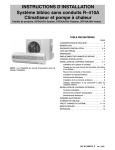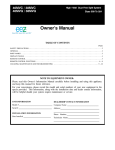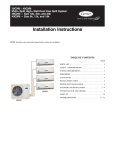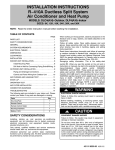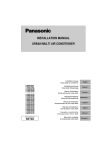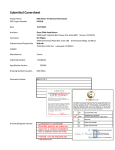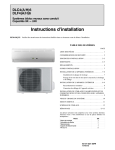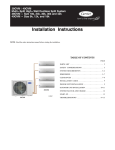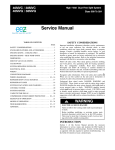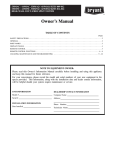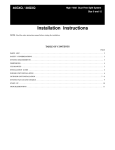Download Carrier 38MVQ Unit installation
Transcript
40MVC / 38MVC 40MVQ / 38MVQ High---Wall Duct Free Split System Sizes 009 to 024 Installation Instructions TABLE OF CONTENTS PAGE PARTS LIST . . . . . . . . . . . . . . . . . . . . . . . . . . . . . . . . . . . . . . . 2 SAFETY CONSIDERATIONS . . . . . . . . . . . . . . . . . . . . . . . . . 3 GENERAL . . . . . . . . . . . . . . . . . . . . . . . . . . . . . . . . . . . . . . . . . 3 SYSTEM REQUIREMENTS . . . . . . . . . . . . . . . . . . . . . . . . . . 3 DIMENSIONS . . . . . . . . . . . . . . . . . . . . . . . . . . . . . . . . . . . . . . 4 SERVICE VALVE LOCATIONS . . . . . . . . . . . . . . . . . . . . . . . . 4 CLEARANCES . . . . . . . . . . . . . . . . . . . . . . . . . . . . . . . . . . . . . 5 INSTALLATION TIPS . . . . . . . . . . . . . . . . . . . . . . . . . . . . . . . 6 INDOOR UNIT INSTALLATION . . . . . . . . . . . . . . . . . . . . . . . 6 OUTDOOR UNIT INSTALLATION . . . . . . . . . . . . . . . . . . . . . 7 INSTALL ALL POWER AND INTERCONNECTING WIRING TO OUTDOOR UNIT . . . . . . . . . . . . . . . . . . . . . . . . . . . . . . 8--9 INSTALL ALL POWER, INTERCONNECTING WIRING, AND PIPING TO INDOOR UNIT . . . . . . . . . . . . . . . . . . . . . 10 REMOTE CONTROL INSTALLATION . . . . . . . . . . . . . . . . . 10 SYSTEM VACUUM AND CHARGE . . . . . . . . . . . . . . . . . . . 11 START--UP . . . . . . . . . . . . . . . . . . . . . . . . . . . . . . . . . . . . . . . . 12 TROUBLESHOOTING . . . . . . . . . . . . . . . . . . . . . . . . . . . . . . 13 the environmentally sound refrigerant NOTE: Read the entire instruction manual before starting the installation. PARTS LIST Part No. 1 2 3 4 5 6 Name of Part Part No. 1 2 3 4 5 6 Qty Mounting Plate Mounting Screw ST3.9x25 ---C ---H Anchor Remote Control Remote Control Holder Mounting Screw B ST2.0x10 ---C ---H 1 8 8 1 1 2 Name of Part Qty Mounting Plate Mounting Screw A ST3.9x25 ---C ---H Anchor Remote Control Remote Control Holder Mounting Screw B ST2.0x10 ---C ---H 2 3 1 8 8 1 1 2 3 1 2 38/40MVC, MVQ 3 1 Air filte r 4 Air Remote Control filte r Mounting screw B ST2.9X10-C-H Remote control holder 6 4 Remote control 6 5 5 Remote control holder Air Inlet Air Inlet Air outlet Loop the connecting cable. Loop the connecting cable. Remove the water receiver first before connecting the pipes. A07334a A07335a Fig. 1 --- 40MVC,MVQ/38MVC,MVQ009--012 Parts List Fig. 2 --- 40MVC, MVQ/38MVC,MVQ018--024 Parts List Note: --- If the outdoor unit is higher than the indoor unit, prevent rain from flowing into the indoor unit along the connection pipe by making a downward arc in the connection pipe before it enters the wall to the indoor unit. This will ensure that rain will drip from the connection pipe before it enters the wall. --- The illustration above is only a sketch. Different models may be slightly different. 2 SAFETY CONSIDERATIONS GENERAL Installing, starting up, and servicing air--conditioning equipment can be hazardous due to system pressures, electrical components, and equipment location (roofs, elevated structures, etc.). Only trained, qualified installers and service mechanics should install, start--up, and service this equipment. Untrained personnel can perform basic maintenance functions such as cleaning coils. All other operations should be performed by trained service personnel. When working on the equipment, observe precautions in the literature and on tags, stickers, and labels attached to the equipment. Follow all safety codes. Wear safety glasses and work gloves. Keep quenching cloth and fire extinguisher nearby when brazing. Use care in handling, rigging, and setting bulky equipment. Read these instructions thoroughly and follow all warnings or cautions included in literature and attached to the unit. Consult local building codes and National Electrical Code (NEC) for special requirements. Recognize safety information. This is the These instructions cover the installation, start--up and servicing of 38MVC,MVQ outdoor and 40MVC, MVQ indoor units duct free systems. Allow sufficient space for airflow and servicing unit. See Fig. 3 and 4 for minimum required distances between unit and walls or ceilings. Piping IMPORTANT: Both refrigerant lines must be insulated separately. S Minimum refrigerant line length between the indoor and outdoor units is 10 ft. (3 m). S The following maximum lengths are allowed: Unit Size 9K 12K 18K 24K ELECTRICAL SHOCK HAZARD Failure to follow this warning could result in personal injury or death. Before installing, modifying, or servicing system, main electrical disconnect switch must be in the OFF position. There may be more than 1 disconnect switch. Lock out and tag switch with a suitable warning label. ! CAUTION EQUIPMENT DAMAGE HAZARD Failure to follow this caution may result in equipment damage or improper operation. 65 (20) 65 (20) 100 (30) 100 (30) 35 (11) 35 (11) 50 (15) 60 (18) 35 (11) 35 (11) 50 (15) 60 (18) S The following are the piping sizes. PIPE SIZES Mix Phase 1/4” 1/4” 1/4” 3/8” Unit Size 9K 12K 18K 24K Vapor 3/8” 1/2” 1/2” 5/8” Refrigerant Charge WARNING ! REFRIGERANT LINE LENGTHS ft. (m) Max Elevation Max Elevation Max Line Length (ID over OD) (OD over ID) Unit Size REFRIGERANT CHARGE lb. (kg) Air Conditioner 9K 12K 18K 24K 2.3 (1.0) 2.9 (1.3) 4.4 (2.0) 5.3 (2.4) Heat Pump 2.4 (1.1) 3.0 (1.4) 4.5 (2.0) 5.3 (2.4) S Above charge is for piping runs up to 25 ft. (7.6 m). S For piping runs greater than 25 ft. (7.6 m), add 0.1 oz. of refrigerant per foot of extra piping up to the allowable length. S Capillary tubes in outdoor unit are used as metering devices. Connecting (Power and Control Cable) S The main power is supplied to the outdoor unit. The field supplied connecting cable from the outdoor unit to indoor unit consists of four wires and provides the power for the indoor unit as well as the communication signal between the outdoor and indoor unit. For 9K and 12K units, all four wires are low voltage DC. For 18K and 24K, two wires are high voltage AC power, one is pulse DC and one is a ground wire. S Consult local building codes, NEC (National Electrical Code) or CEC (Canadian Electrical Code) for special requirements. Do not bury more than 36 in. (914 mm) of refrigerant pipe in the ground. If any section of pipe is buried, there must be a 6 in. (152 mm) vertical rise to the valve connections on the outdoor units. If more than the recommended length is buried, refrigerant may migrate to the cooler buried section during extended periods of system shutdown. This causes refrigerant slugging and could possibly damage the compressor at start--up. Model Size Power Source 9k 115 ---1 ---60 12k 12k MIN CKT AMP MAX FUSE/CB AMP 12/20 15/25 9/15 18k 208/230 ---1 ---60 24k 11/20 14/25 S Connecting Cable: Voltage drop on the connecting cable should be kept to a minimum. Do not use thermostat wire. Use cable size and max length below: 18 AWG 16 AWG 3 50 Feet (16 m) 100 Feet (33 m) 38/40MVC, MVQ safety--alert symbol ! . When you see this symbol on the unit and in instructions or manuals, be alert to the potential for personal injury.Understand these signal words: DANGER, WARNING, and CAUTION. These words are used with the safety--alert symbol. DANGER identifies the most serious hazards which will result in severe personal injury or death. WARNING signifies hazards which could result in personal injury or death. CAUTION is used to identify unsafe practices which may result in minor personal injury or product and property damage. NOTE is used to highlight suggestions which will result in enhanced installation, reliability, or operation. SYSTEM REQUIREMENTS DIMENSIONS -- INDOOR A07336 W in. (mm) 32.09 (815) 35.67 (906) 49.21 (1250) 49.21 (1250) Model Size D in. (mm) 7.68 (195) 9.25 (235) 9.06 (230) 9.06 (230) Operating Weight lb (kg) 17.6 (8) 25.3 (11.5) 39.6 (18) 39.6 (18) DIMENSIONS - OUTDOOR Air Flow H W L1 L2 D 38/40MVC, MVQ 9K 12K 18K 24K H in. (mm) 11.02 (280) 11.26 (286) 12.80 (325) 12.80 (325) 35 A07337 Model Size W in. (mm) H in. (mm) L1 in. (mm) L2 in. (mm) L3 in. (mm) 9K 12K 18K 24K 30.71 (780) 29.92 (760) 33.07 (840) 35.00 (889) 21.26 (540) 23.23 (590) 27.36 (695) 33.50 (851) 21.61 (549) 20.87 (530) 22.05 (560) 23.11 (588) 11.81 (300) 12.40 (315) 14.17 (360) 13.98 (355) 10.87 (276) 11.42 (290) 13.19 (335) 13.11 (333) Operating Weight lb (kg) Cooling Only 70.4 (32) 79.2 (36) 116.6 (53) 149.6 (68) Operating Weight lb (kg) Heat Pumps 72.6 (33) 83.6 (38) 117.7 (53.5) 151 (68.5) SERVICE VALVE LOCATIONS 24K 18K 12K 9K K J K J J K K J A07376a Service Valve Locations J K 9K in. (mm) 3.46 (88) 3.46 (88) 12K in. (mm) 3.19 (81) 5.63 (143) 4 18K in. (mm) 3.46 (88) 3.62 (92) 24K in. (mm) 4.02 (102) 6.57 (167) CLEARANCES -- INDOOR CEILING 6" (0.15m) min. 5" (0.13m) min. 5" (0.13m) min. 6' (1.8m) 38/40MVC, MVQ FLOOR A07891 Fig. 3 --- Indoor unit clearance CLEARANCES - OUTDOOR A Air-inlet E D B C Air-outlet A07894 UNIT A B C D E 9k and 12k in. (mm) 24 (610) 24 (610) 24 (610) 6 (152) 12 (305) Fig. 4 --- Outdoor Unit Clearance 5 18k and 24k in. (mm) 24 (610) 36 (914) 24 (610) 6 (152) 12 (305) Ideal installation locations include: Indoor Unit S A location where there are no obstacles near inlet and outlet area. S A location which can bear the weight of indoor unit. S Do not install indoor units near a direct source of heat such as direct sunlight or a heating appliance. S A location which provides appropriate clearances as outlined in Fig. 3. Outdoor Unit S A location which is convenient to installation and not exposed to strong wind. If unit is exposed to strong winds it is recommended that a wind baffle be used. Contact your Duct Free Split representative for drawings. S A location which can bear the weight of outdoor unit and where the outdoor unit can be mounted in a level position. S A location which provides appropriate clearances as outlined in Fig. 4. S Do not install the indoor or outdoor units in a location with special environmental conditions. For those applications, contact your Duct Free Split representative. INDOOR UNIT INSTALLATION INSTALL MOUNTING PLATE 1. Carefully remove the mounting plate, which is attached to the back of the indoor unit. 2. The mounting plate should be located horizontally and level on the wall. All minimum spacings shown in Fig. 3, 4, 5, 6, and 7 should be maintained. 3. If the wall is block, brick, concrete or similar material, drill .2” (5 mm) diameter holes and insert anchors for the appropriate mounting screws. 4. Attach the mounting plate to the wall. DRILL HOLE IN WALL FOR INTERCONNECTING PIPING, DRAIN AND WIRING Refrigerant Line Routing The refrigerant lines may be routed in any of the four directions shown in Fig. 9. For maximum serviceability, it is recommended to have refrigerant line flare connections and the drain connections on the outside of the wall that the fan coil can be mounted on. If piping is going through the back: 1. Determine pipe hole position using the mounting plate as a template. Drill pipe hole diameter per chart below. The outside pipe hole is 1/2--in. (13 mm) min. lower than inside pipe hole, so it slants slightly downward (see Fig. 8). The mounting plate will look like one of the following depending on model size: 1/2 in. (13 mm) Min. 6"(152) min. to ceiling Mounting Plate Indoor unit outline Left rear side refrigerant pipe hole o 65 5.20" (132) 3.19" (81) 11.10" (282" 4.72" (120) or more to wall 23.50"(597) 4.72" (120) or more to wall 3.54" (90) 1.77"(45) INDOOR Right rear side refrigerant pipe hole o 65 1.77" (45) A07371 1.77" (45) NOTE: Measurements in ( ) are in mm. 009, 012 018, 024 A07338 1.57" (40) Indoor unit outline 6" (152) min. to ceiling Hole Diameter in. (mm) 2.75 (70) 3.75 (95) Model Size 6'(1.8 m) min. to floor Fig. 5 --- Mounting Plate-- Model size 009 Mounting Plate If piping is going through the right or left side: 1. Use a small saw blade to carefully remove the corresponding plastic covering on side panel and drill the appropriate size hole where the pipe is going through the wall. 2.05" (52) 32.01" (813) 4.72" (120) or more to wall 4.72" (120) or more to wall OUTDOOR Fig. 8 --- Drill Holes 32.09" (815) 11.26" (286) 1.99" (50) 1.99" (50) Rear-left pipe hole o 65mm Rear-left pipe hole o 65mm Pipe holder 35.63" (905) 3.86" (98) 2.17" (55) 5.00" (127) Pipe cover 3.54" (90) 4 6' (1.8 m) min. to floor A07339 Pipe cover 3 Left piping Left back piping Fig. 6 --- Mounting Plate-- Model size 012 1 2 Right back piping Right piping 6" (152) min. from ceiling 7.01" (178) Above 4.72" (120) from the wall 49.21" (1250) 32.09" (815) Hooked Part Hooked Part 10.12" (257) 95 95 Size 012 Only Mounting Plate 12.80" (325) 38/40MVC, MVQ INSTALLATION TIPS A07344 Above 4.72" (120) from the wall Fig. 9 --- Piping Locations 2.17" (55) Pipe hole Indoor unit outline 2.28" (58) Pipe hole 2.17" (55) 2.17" (55) 6' (1.8 m) min. to floor A07340 Fig. 7 --- Mounting Plate-- Model sizes 018 -- 024 6 1. Use a rigid base to support unit in a level position. NOTE: For applications requiring cooling with outdoor temperatures below 55_F (13_C), a low ambient control field--installed accessory is available. Consult the Installation Instruction for the low ambient kit for further information. If the installation location may be exposed to strong wind , use a wind baffle. Check with your Carrier representative to obtain drawings for wind baffles. Strong wind A07350 Fig. 10 --- High Wind Installation 2. Locate outdoor unit and connect piping and wiring. MAKE REFRIGERANT PIPING CONNECTIONS (OUTDOOR UNIT) IMPORTANT: Use refrigeration grade tubing ONLY. No other type of tubing may be used. Use of other types of tubing will void manufacturer’s warranty. Do not open service valves or remove protective caps from tubing ends until all the connections are made. Bend tubing with bending tools to avoid kinks and flat spots. Keep the tubing free of dirt, sand, moisture, and other contaminants to avoid damaging the refrigerant system. Avoid sags in the suction line to prevent the formation of oil traps. Insulate each tube with minimum 3/8--in. (10 mm) wall thermal pipe insulation. Inserting the tubing into the insulation before making the connections will save time and improve installation quality. 1. Remove service valve cover if provided with unit. 2. Cut tubing with tubing cutter. Remove service connection if provided with unit. 3. Install correct size flare nut onto tubing and make flare connection. 4. Apply a small amount of refrigerant oil to the flare connection on the tubing. 5. Properly align tubing in with service valve. 6. Tighten flare nut and finish installation using two wrenches as shown in Fig. 11. A07354 Fig. 11 --- Tighten Flare Nut ! CAUTION EQUIPMENT DAMAGE HAZARD Failure to follow this caution may result in equipment damage or improper operation. Excessive torque can break flare nut depending on installation conditions. 7 38/40MVC, MVQ OUTDOOR UNIT INSTALLATION INSTALL ALL POWER AND INTERCONNECTING WIRING TO OUTDOOR UNITS 38/40MVC, MVQ 1. Mount outdoor power disconnect. 2. Run power wiring from main box to disconnect per NEC and local codes. 3. Remove field wiring cover from unit by loosening screws. 4. Remove caps on conduit panel. 5. Connect conduit to conduit panel. (See Fig.12 ) 6. Properly connect both power supply and control lines to terminal block per the connection diagram for the appropriate unit capacity and voltage. (See Fig. 13) 7. Ground unit in accordance with NEC and local electrical codes. 8. Use lock nuts to secure conduit. 9. Reinstall field wiring cover. Outdoor CAUTION ! EQUIPMENT DAMAGE HAZARD Failure to follow this caution may result in equipment damage or improper operation. S Be sure to comply with local codes while running wire from indoor unit to outdoor unit. S Every wire must be connected firmly. Loose wiring may cause terminal to overheat or result in unit malfunction. A fire hazard may also exist. Therefore, be sure all wiring is tightly connected. S No wire should be allowed to touch refrigerant tubing, compressor or any moving parts. S Disconnecting means must be provided and shall be located within sight and readily accessible from the air conditioner. S Connecting cable with conduit shall be routed through hole in the conduit panel. unit Terminal Block Ove r 1.5 7" ( 40m m) Conduit panel G Conduit A07455 Fig. 12 --- Field Wiring ELECTRICAL DATA UNIT SIZE 009 012 OPERATING VOLTAGE MAX/MIN 127/104 COMPRESSOR VOLTS--- PH--- HZ 115 ---1 ---60 012 018 024 253/187 208/230 ---1 ---60 OUTDOOR FAN RLA LRA 7.5 40 9.9 47 5.2 FLA HP W INDOOR FAN VOLTS 0.69 0.102 23 35 DC 21 0.38 0.116 36 35 DC 7.3 32.6 0.78 0.224 53 9.7 34.8 0.62 0.218 100 8 208/230 ---1 ---60 MCA MAX FUSE/CB AMP FLA HP W 1.1 0.034 20 12 20 1.18 0.044 25 15 25 1.18 0.044 25 9 15 0.26 0.075 31 11 20 0.39 0.112 50 14 25 CONNECTION DIAGRAMS CONNECTING CABLE CONTROL 38/40MVC, MVQ CONTROL CONNECTING CABLE CONNECTING CABLE Notes: 1. Do not use thermostat wire for any connection between indoor and outdoor units. 2. All connections between indoor and outdoor units must be as shown. The connections are sensitive to polarity. 3. On the 18k and 24k units, the “S” terminal “CONTROL” output is pulse DC with a potential AC voltage shock hazard. A07654 Fig. 13 --- Connection Diagrams 9 38/40MVC, MVQ INSTALL ALL POWER, INTERCONNECTING WIRING, AND PIPING TO INDOOR UNIT. 1. Run interconnecting piping and wiring from outdoor unit to indoor unit. 2. Run interconnecting cable through hole in wall (outside to inside). 3. Lift indoor unit into position and route piping and drain through hole in wall (inside to outside). Fit interconnecting wiring into back side of indoor unit. 4. Put upper claw at back of indoor unit on upper hook of Mounting Plate, move indoor unit from side to side to see that it is securely hooked. 5. Open front cover of indoor unit and remove field wiring terminal block cover. 6. Pull interconnecting wire up from back of indoor unit and position in close to the terminal block on indoor unit. 7. Push lower part of indoor unit up on wall, then move indoor unit from side to side, up and down to check if it is hooked securely. (See Fig. 14.) Do not put the drain end into water. Do not form a rise. A07342 Fig. 15 --- Proper Drain Hose Installation NOTE: For proper orientation of the refrigerant piping, electrical cable and drain lines, refer to Fig. 16. Indoor unit Interconnecting Wiring .. . . . . Upper hook .. . . . . . . . .. . .. .. . . ... .. . . Lower hook . Refrigerant Piping Tape Drain Piping A07346 Fig. 16 --- Proper Orientation A07347a Fig. 14 --- Indoor Unit Installation 8. Connect wiring from outdoor unit per connection diagram (see Fig. 13 and Fig. 17). 9. Replace field wiring cover and close front cover of indoor unit. 10. Connect refrigerant piping and drain line outside of indoor unit. Refer to Fig. 11 for proper installation of flare connections. Complete pipe insulation at flare connection then fasten piping and wiring to the wall as required. Completely seal the hole in the wall. 11. Connect the drain line. The drain line must not have a trap anywhere in its length, must pitch downwards, and must be insulated up to the outside wall. See Fig. 15. Panel NOTE: For applications where gravity cannot be used for drainage, a condensate pump accessory is available. Consult the condensate pump Installation Instructions for more information. REMOTE CONTROL INSTALLATION Mounting Bracket (if installed on the wall) 1. Use the two screws supplied with control to attach Mounting Bracket to wall in location selected by customer and within operating range. 2. Install batteries in Remote Control. 3. Place Remote Control into remote control Mounting Bracket. 4. For remote control operation, refer to the unit Owner’s Manual. Control Box Cover 18k & 24k Terminal block 9k & 12k Terminal block of indoor unit L1 L2 208/230-1-60 From outdoor unit to indoor unit Barrier between high and low voltage S G 1 2 3 4 35v DC from outdoor to indoor Control: Pulse DC between outdoor unit and indoor unit with a potential AC voltage shock hazard. 12v DC from outdoor unit to indoor unit To Outdoor Unit To outdoor unit A07349a Fig. 17 --- Control and Power Wiring on Indoor Unit 10 UNIT DAMAGE HAZARD Failure to follow this caution may result in equipment damage or improper operation. Deep Vacuum Method The deep vacuum method requires a vacuum pump capable of pulling a vacuum of 500 microns and a vacuum gage capable of accurately measuring this vacuum depth. The deep vacuum method is the most positive way of assuring a system is free of air and liquid water. (See Fig. 20) 5000 4500 4000 3500 3000 2500 2000 1500 1000 500 Never use the system compressor as a vacuum pump. SYSTEM VACUUM AND CHARGE Using Vacuum Pump 1. Completely tighten flare nuts A, B, C, D, connect manifold gage charge hose to a charge port of the low side service valve. (See Fig. 18) 2. Connect charge hose to vacuum pump. 3. Fully open the low side of manifold gage. (See Fig. 19) 4. Start vacuum pump 5. Evacuate using either deep vacuum or triple evacuation method. 6. After evacuation is complete, fully close the low side of manifold gage and stop operation of vacuum pump. 7. The factory charge contained in the outdoor unit is good for up to 25 ft. (8 m) of line length. For refrigerant lines longer than 25 ft (8 m), add 0.1 oz. per foot of extra piping up to the maximum allowable length. 8. Disconnect charge hose from charge connection of the low side service valve. 9. Fully open service valves B and A. 10. Securely tighten caps of service valves. Indoor Unit Refrigerant Outdoor Unit A Low Side B High Side C D LEAK IN SYSTEM MICRONS Refrigerant tubes and indoor coil should be evacuated using the recommended deep vacuum method of 500 microns. The alternate triple evacuation method may be used if the procedure outlined below is followed. Always break a vacuum with dry nitrogen. VACUUM TIGHT TOO WET TIGHT DRY SYSTEM 0 1 2 3 4 5 MINUTES 6 7 A95424 Fig. 20 --- Deep Vacuum Graph Triple Evacuation Method The triple evacuation method should only be used when vacuum pump is only capable of pumping down to 28 in. of mercury vacuum and system does not contain any liquid water. Refer to Fig. 21 and proceed as follows: 1. Pump system down to 28 in. of mercury and allow pump to continue operating for an additional 15 minutes. 2. Close service valves and shut off vacuum pump. 3. Connect a nitrogen cylinder and regulator to system and open until system pressure is 2 psig. 4. Close service valve and allow system to stand for 1 hr. During this time, dry nitrogen will be able to diffuse throughout the system absorbing moisture. 5. Repeat this procedure as indicated in Fig. 21. System will then be free of any contaminants and water vapor. EVACUATE Service Valve A07360 BREAK VACUUM WITH DRY NITROGEN Fig. 18 --- Service Valve WAIT Manifold Gage EVACUATE BREAK VACUUM WITH DRY NITROGEN 500 microns Low side valve Charge hose WAIT High side valve EVACUATE Charge hose CHECK FOR TIGHT, DRY SYSTEM (IF IT HOLDS DEEP VACUUM) Vacuum pump RELEASE CHARGE INTO SYSTEM Low side valve A95425 Fig. 21 --- Triple Evacuation Method A07361 Fig. 19 --- Manifold Final Tubing Check IMPORTANT: Check to be certain factory tubing on both indoor and outdoor unit has not shifted during shipment. Ensure tubes are not rubbing against each other or any sheet metal. Pay close attention to feeder tubes, making sure wire ties on feeder tubes are secure and tight. 11 38/40MVC, MVQ CAUTION ! START--UP Test Operation Perform test operation after completing gas leak and electrical safety check. (See Fig.. 22) SYSTEM CHECKS 1. Conceal the tubing where possible. 2. Make sure that the drain tube slopes downward along its entire length. 3. Ensure all tubing and connections are properly insulated. 4. Fasten tubes to the outside wall, when possible. 5. Seal the hole through which the cables and tubing pass. 38/40MVC, MVQ INDOOR UNIT AUTO/COOL Manual Button A07363 Fig. 22 --- Test Operation 1. Push the “ON/OFF” button on Remote Control to begin testing. NOTE: A protection feature prevents air conditioner from being activated for approximately 3 minutes. 2. Push MODE button, select COOLING, HEATING, FAN mode to check if all functions work correctly. 3. When ambient temperature is lower than 63_F/17_C, the unit cannot be controlled by Remote Control to run in cooling mode. For this condition, manual operation must be used. (1.) Open front panel of the indoor unit; (2.) Push the manual switch once to energize the unit. 4. Be sure to set manual switch to “OFF” (by pushing it twice) after finishing test operation. NOTE: For Heat Pumps, follow the same procedure. 1. 2. 3. 4. Do all Remote Control buttons function properly? Do the display panel lights work properly? Does the air deflection louver function properly? Does the drain work? OUTDOOR UNIT 1. Are there unusual noises or vibrations during operation? Explain Following Items To Customer With The Aid Of The Owner’s Manual: 1. How to turn air conditioner on and off; selecting COOLING, HEATING and other operating modes; setting a desired temperature; setting the timer to automatically start and stop air conditioner operation; and all other features of the Remote Control and display panel. 2. How to remove and clean the air filter. 3. How to set air deflection louver. 4. Explain care and maintenance. 5. Present the Owner’s Manual and installation instructions to customer. 12 TROUBLESHOOTING For ease of service, the systems are equipped with diagnostic code display LEDs on both the indoor and outdoor units. The outdoor diagnostic display is an LED on the outdoor unit board and is limited to very few errors. However, it is useful in identifying special error codes like a failure of the outdoor coil sensor on heat pumps. The indoor diagnostic display is a combination of flashing LEDs on the display panel or the front of the unit. If possible, always check the diagnostic codes displayed on the indoor unit first. The diagnostic codes for the indoor and outdoor units are listed in the tables below. INDOOR UNIT DIAGNOSTIC GUIDES 9K & 12K Units Timer Lamp X On l l l Failure Mode Indoor fan speed has been out of control for over 1 minute Indoor room temp. or evaporator sensor is open circuit or short circuited Compressor over--- current protection has been activated four times EEROM error Indoor unit communication error (Illuminates simultaneously) 18K & 24K Units Operation Lamp l X l Timer Lamp l l X Defrosting Lamp l X X Auto Lamp l X X X X l X X X X l = Flashing X l X l X X l l l Failure Mode Over--- current protection of the compressor occurs four times Indoor room temp. sensor is open circuit or short circuited Temp. sensor on indoor evaporator is open circuit or short circuited Temp. sensor on outdoor condenser is open circuit or short circuited (not cooling only modes) Outdoor unit protects (outdoor temp. sensor, phase order, etc.) EEROM error Indoor unit communication error X = Off For additional diagnostic information, refer to the Service Manual. Infrared signal receptor Infrared signal receptor AUTO OPERATION AUTO TIMER ECON PRE-DEF TIMER PRE.-DEF* OPERATION TIMER OPERATION PRE-DEF A08483 A07544 A08486 HP Model size 012 HP Model size 009 HP Model size 018-- 024 * PRE--DEF light will illuminate when the unit is running in FAN ONLY mode on Cooling Only units. Note: Cooling only units have same LED lights but without PRE--DEF print. Fig. 23 --- LED Display Panel OUTDOOR UNIT DIAGNOSTIC GUIDES Flashing Times after 2 Second Off 5 2 1 Failure Mode Communication failure Condenser temperature sensor failure Other indoor failure Diagnostic Chart 4 or 6 2 – If the unit is operating normally, the LED light on the outdoor board is lit continuously. If there is a failure, the LED light will flash a specific number of times. Refer to the Outdoor Unit Diagnostic table above to determine failure. 13 38/40MVC, MVQ Operation Lamp l l X On l 38/40MVC, MVQ Copyright 2012 Carrier Corporation S 7310 W. Morris St. S Indianapolis, IN 46231 Edition Date: 06/12 Manufacturer reserves the right to change, at any time, specifications and designs without notice and without obligations. 14 Catalog No: 38---40MV ---7SI Replaces: 38--- 40MV--- 6SI














